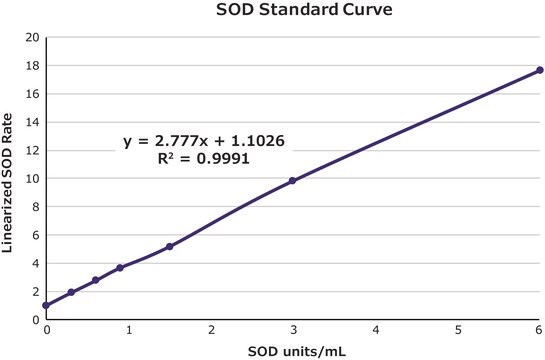MAK100
Inosine Assay Kit
sufficient for 100 fluorometric tests
Synonym(s):
Inosine Fluorometric Assay Kit
Sign Into View Organizational & Contract Pricing
All Photos(2)
About This Item
UNSPSC Code:
12161503
NACRES:
NA.84
Recommended Products
usage
sufficient for 100 fluorometric tests
detection method
fluorometric
relevant disease(s)
cardiovascular diseases; immunological diseases
storage temp.
−20°C
General description
Inosine is a purine nucleotide found at the wobble position of tRNA where it plays a role in the proper translation of mRNA at the ribosome. In addition to its role in translation, inosine also plays important roles in the immune system where is exhibits both inflammatory and anti-inflammatory effects. Inosine may be tissue protective during ischemic injury and recent reports suggest inosine may preserve cell viability during hypoxia.
Application
Inosine Assay Kit has been used for the detection of inosine in the brain tissue homogenates.
Suitability
Suitable for the measurement of inosine in a variety of samples including tissue and cells
Principle
The Inosine Assay Kit provides a simple and direct procedure for measuring inosine in a variety of samples. Inosine concentration is determined by a coupled enzyme reaction in which inosine is converted to hypoxanthine which reacts with the substrate mix and probe, resulting in a fluorometric product (λex = 535/λem = 587 nm), proportional to the inosine present.
Storage Class Code
10 - Combustible liquids
Flash Point(F)
188.6 °F - closed cup
Flash Point(C)
87 °C - closed cup
Choose from one of the most recent versions:
Certificates of Analysis (COA)
Lot/Batch Number
Don't see the Right Version?
If you require a particular version, you can look up a specific certificate by the Lot or Batch number.
Already Own This Product?
Find documentation for the products that you have recently purchased in the Document Library.
Cell-subtype-specific changes in adenosine pathways in schizophrenia.
O?Donovan S M, et al.
Neuropsychopharmacology, 43, 1667?1674-1667?1674 (2018)
Our team of scientists has experience in all areas of research including Life Science, Material Science, Chemical Synthesis, Chromatography, Analytical and many others.
Contact Technical Service
